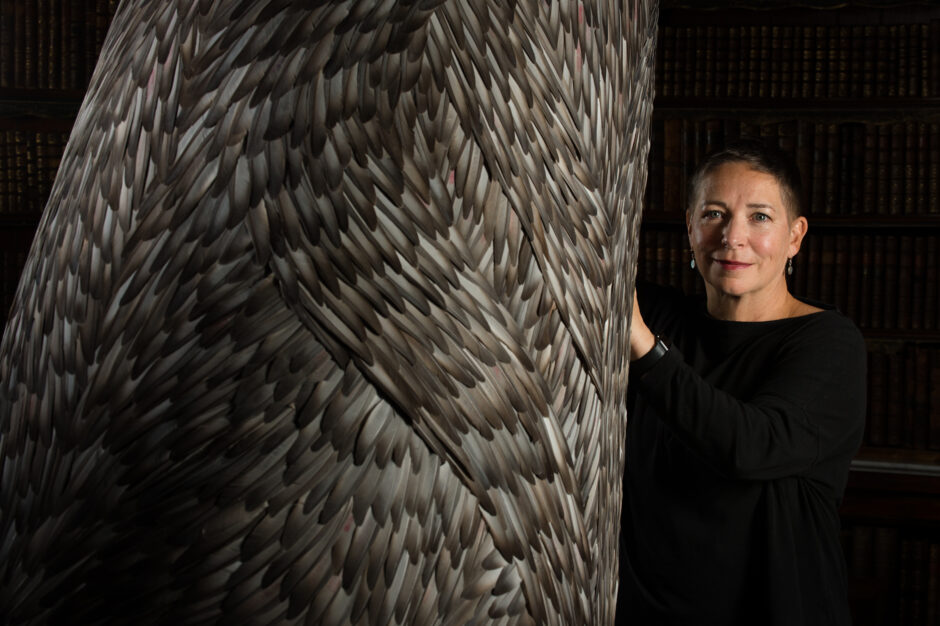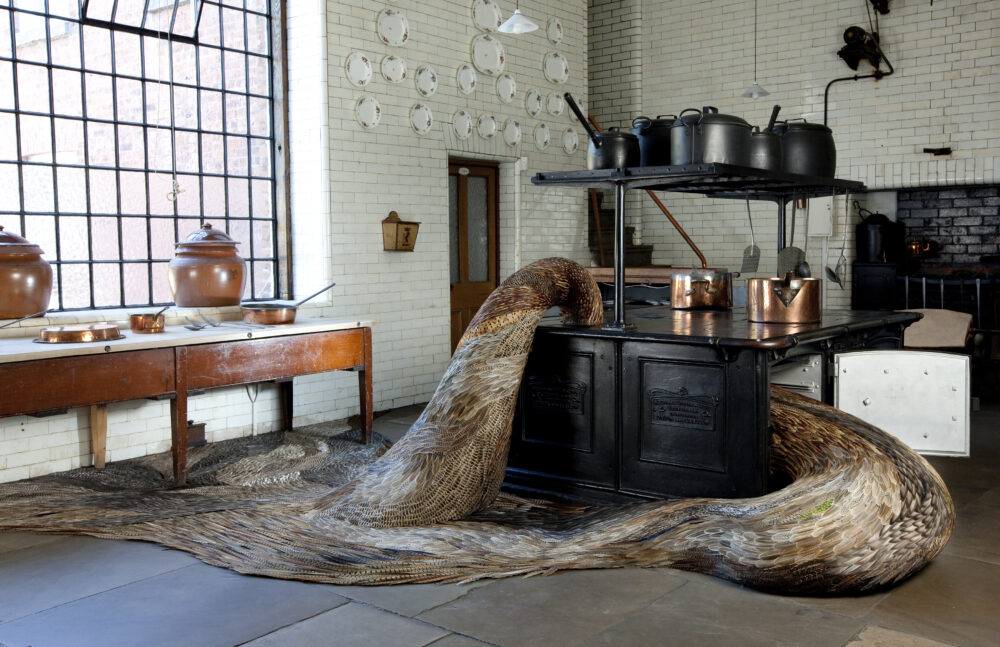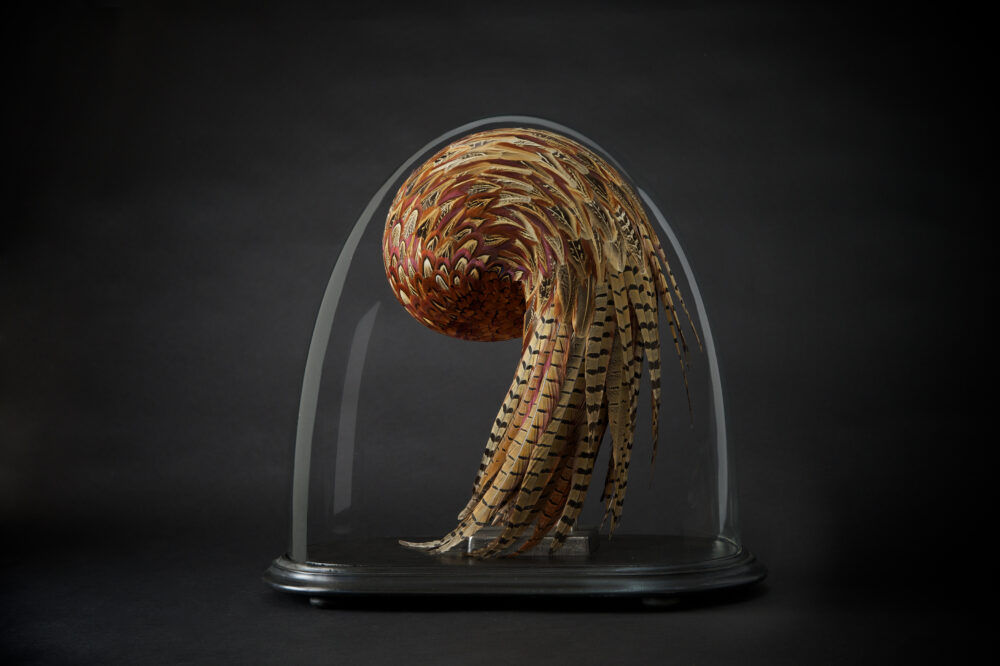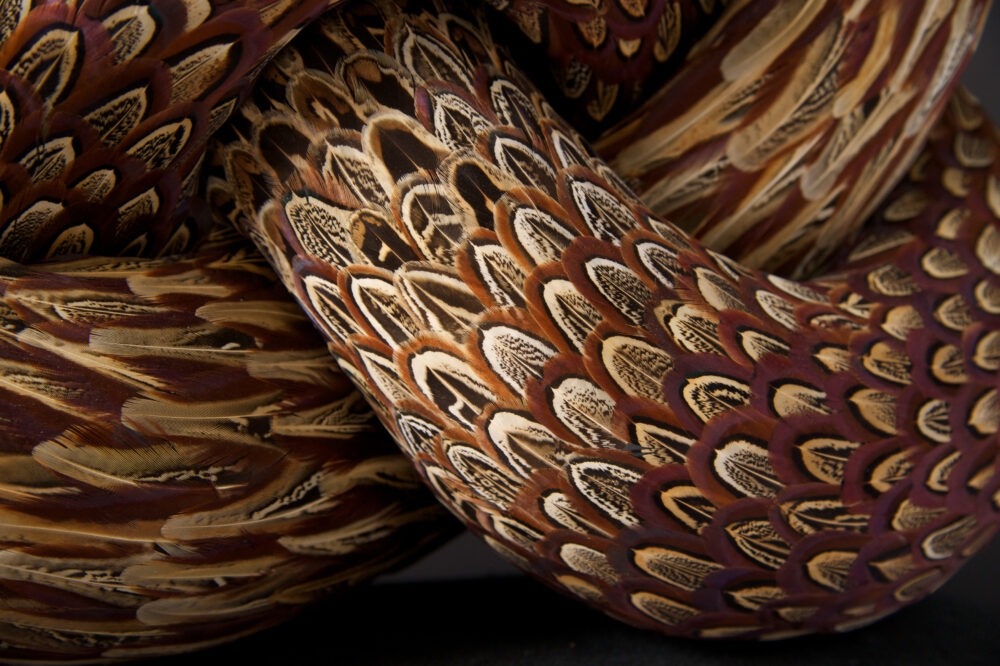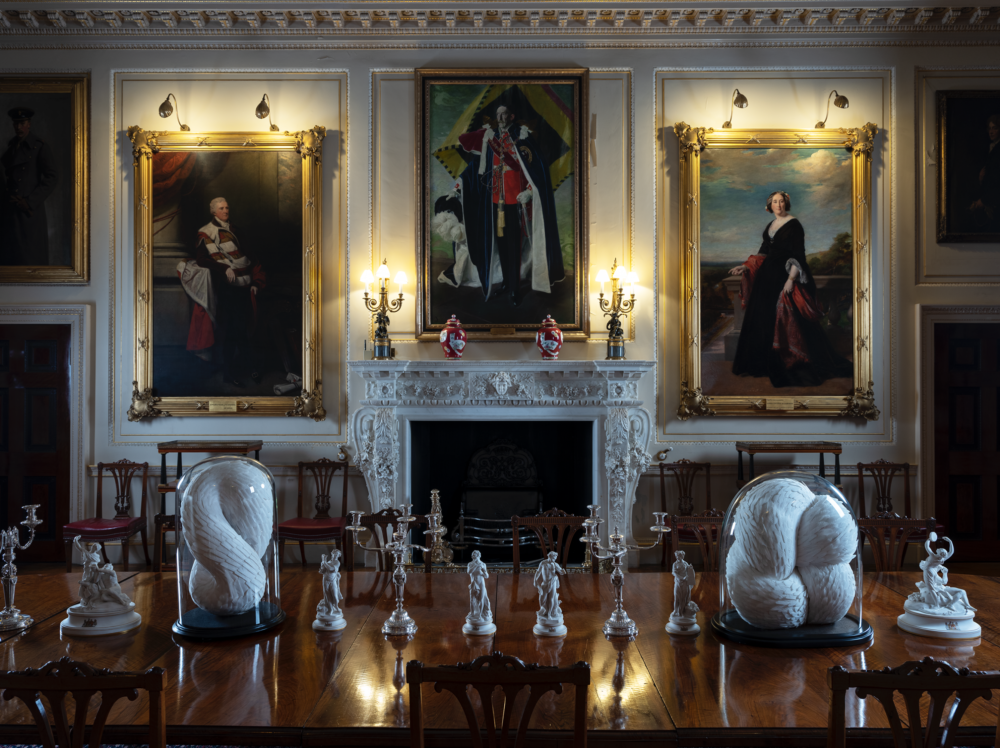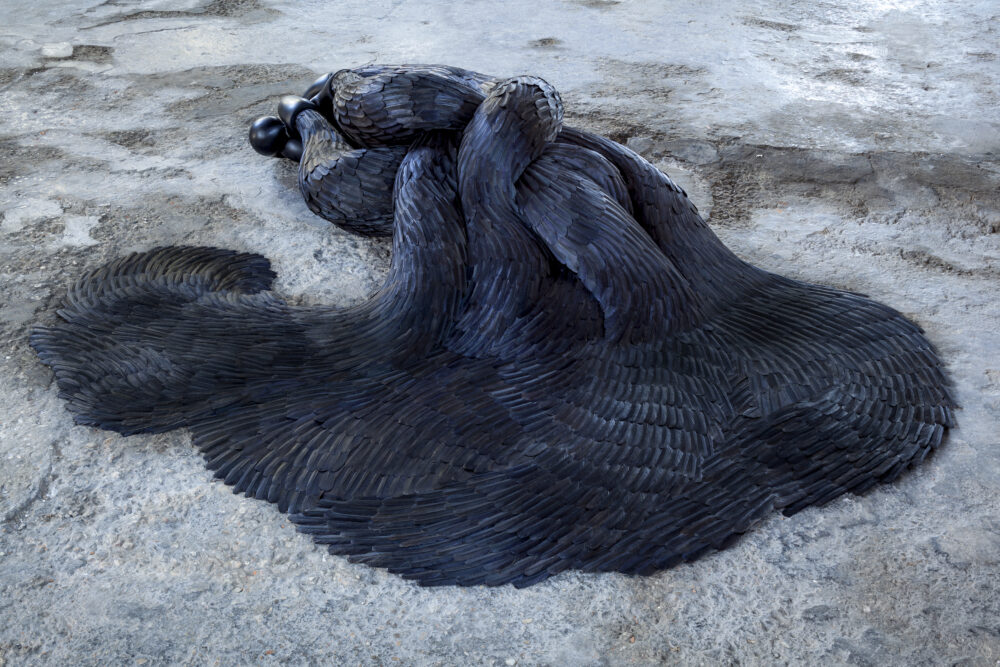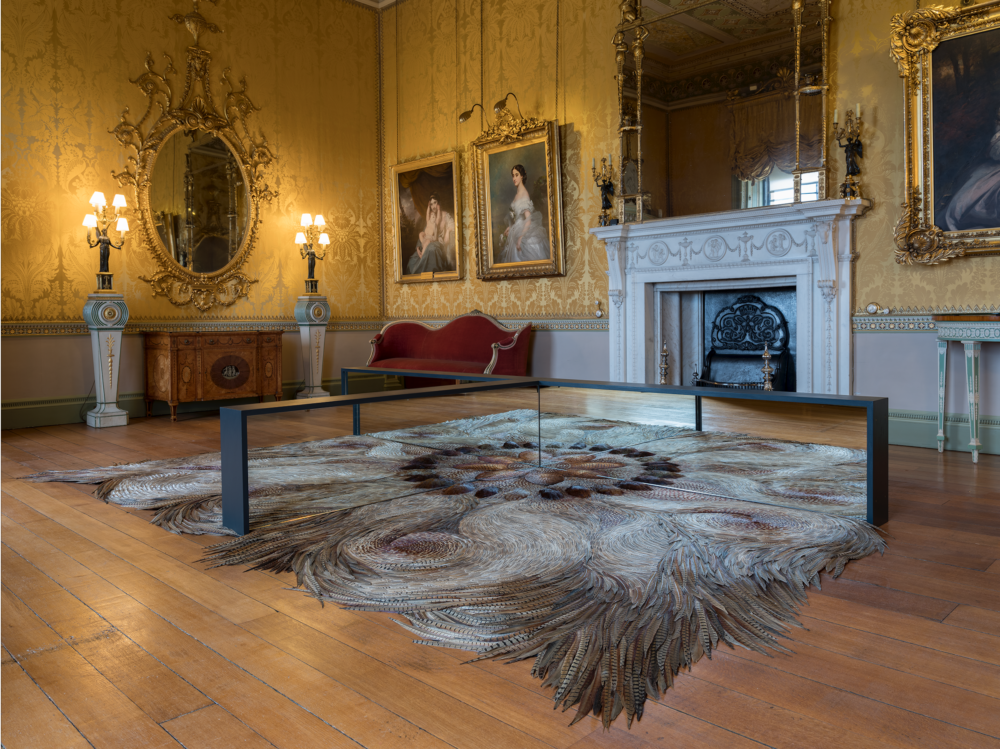KATE MCCGWIRE: FANTASTICAL CREATURES AND ABSTRACT FORMS
Kate MccGwire is a London-based artist renowned for her innovative use of organic materials. Taking feathers as her primary medium, MccGwire creates sculptures and installations that are poised between fantastical creatures and abstract forms, the beautiful and the grotesque. With a major new monograph being released next month, Olivia Forster caught up with MccGwire to find out more about the publication and her recent solo exhibition Menagerie at Harewood House in Leeds.
What was it that first drew you to materials such as bones and feathers, and how did you come to the realisation that you could use them to create works of art?
I was born on a boatyard and spent my childhood on the Norfolk Broads. My early fascination with the region’s landscape, dominated by its wetlands, serpentine waterways and the wildlife that lives along its waters informs my practice, which is inspired by the cycles, patterns and dualities of nature. Looking through early drawings, I recently realised that I made my first drawing of a peacock feather aged ten.
As an artist, I have always worked with organic material, but I had the idea of working with feathers some twenty years ago, after stumbling across some fallen pigeon feathers that landed by the barge on which I have my studio. I started to collect, clean and arrange the feathers and quickly realised that to make anything out of them, I would need thousands. This was the beginning of my contact with pigeon fanciers and gamekeepers from all across the UK. I haven’t looked back since!
Despite being inanimate and abstract, so many of your sculptures seem animalistic and imply movement, whether avian, aquatic or reptilian. A number of your pieces are also presented in glass domes, as if specimens in display cases. How far do you imagine your sculptures as creatures?
I am interested in exploring the dualities of nature through my work: notions of attraction versus repulsion, predator versus prey. Through my practice I examine power structures and I also explore the feminine grotesque. The use of feathers and patterning in my work often creates the implication of creatures that are avian or reptilian, but I like to imagine that my work hovers somewhere between representation and abstraction.
In her text for your new monograph, critic and curator Jane Neal compares your sculptures and installations to creatures from mythology. Are there certain fictional beasts from the history of art, literature or film that have had particular resonance for you?
I have been greatly influenced by the iconic sculpture of Laocoon and His Sons from the Hellenistic Period. As the ‘creatures’ of my works are often bound within the tight confines of glass vitrines and appear frantic and constrained, I have often been told that my works invoke a sense of pathos in the viewer and, like the sculpture of Laocoon, convey an epic notion of universal suffering.
The Pergamon Altar has also had a particular resonance for me, with its depiction of hybrid creatures that are simultaneously seductive and frightening, contained with a composition that is both confusing and harmonious. The tensions at play within the altar have informed my practice greatly.
Your works are often discussed in terms of ideas of the grotesque and the uncanny. What do you think viewers might feel when encountering one of your sculptures?
I am perhaps best known for my larger-scale sculptures and installations, which often invoke the sense of confinement and explore the boundaries between the beautiful and grotesque. I think that viewers often feel claustrophobic or overwhelmed when viewing my works, and as mentioned, they often feel a sense of suffering and pathos. However, some of the works that I make are more subtle, formed using lighter-coloured feathers and more spaciously accommodated within their vitrines.
The publication contains some images of pages from your sketchbooks. Does a new work always begin with drawing?
I always start the process of making my sculptures and installations with sketching, as this gives me as sense of scale and space. However, I very rarely show these sketches, so having them reproduced in my monograph is something that is new to me.
Your sculptures and installations must take a considerable amount of time to create. Could you describe for us the process of making one of your large pieces?
Once I have received the feathers from the pigeon fanciers and gamekeepers, I clean and sort them according to size and form. When feathering, I lose myself in the process for hours, working instinctually – you can’t plan how to lay the feathers out, nor can you really teach someone. Each precise placement of a feather contributes to the overall patterning of a piece and its implicit sense of movement, which gives verisimilitude to the work and brings it to life. This final stage draws on the rituals of craft, on the connection between hand and eye and the natural serendipity that happens when you become fully immersed in giving life to an idea.
You often create site-specific installations in which your sculptures appear to be infiltrating, erupting within, or taking control over, man-made environments. Would you say that the relationship between humankind and the animal kingdom is an important theme in your practice?
The examination of the relationship between humankind and the animal kingdom is integral to my work. Without wanting to become didactic, I hope that my practice highlights our responsibility to the natural world in which animals, our shared landscape and we as humans are interdependent and inseparable.
You recently had a substantial solo exhibition at Harewood House in Leeds, which saw your sculptures and installations interacting with the elegant interiors of this stately home. Could you tell us about the experience of working on the exhibition, and how you approached this particular location?
I was invited to participate in a solo exhibition at Harewood to celebrate the fiftieth anniversary of the house’s magnificent bird garden, a sanctuary for rare and endangered species, which include starlings, cockatoos, macaws and flamingos.
For the exhibition, alongside showing existing works, I was commissioned to create a new, site specific work, which was titled Cavort. The work is made up of some ten thousand pheasant feathers which I selected according to form, size and individual patterning to create an opulent carpet of sorts. The design of this was a direct response to the Yellow Drawing Room where the work was on display: the room’s neoclassical architecture by John Carr, interior by Robert Adam and richly decorated furnishings by Thomas Chippendale. One half of Cavort reproduces the lavish acanthus leaf plasterwork on the room’s stuccoed ceiling; the other reproduces the Axminster carpet, which covers its floor.
Utilising vertical mirrors in a way that was new for me, I experimented with recreating the effect of twilight murmurations in the work: the flocking and directional swarming that certain bird species partake in around dusk. This is where the title Cavort derives from. By integrating a rigid architectural framework into the piece, I wanted to juxtapose man-made material with organic and to play with the contrast between the robust and smooth mirror alongside fluid and textured feathers.
Through the placement of the mirrors, I emphasised repetition of pattern and explored the work formally; the work also hopefully reminds the viewer of further visual sequences found in nature: flora, shells, the scales of a reptile… Though anchored by its use of feathers, I would like this piece to extend beyond the specific into the macrocosmic.
Historically, sculpture has largely been a male-dominated field, though there have been some incredible, high-profile women sculptors whose lives and work have helped to redress this. Are there particular women artists of the past who have inspired or informed your practice?
My practice has been inspired and informed by Eva Hesse, Doris Salcedo, Berlinde de Bruyckere, Louise Bourgeois, Rosemary Trockel and Ruth Asawa.
Dr Catriona McAra, author of the second essay in your new monograph, positions your work within the lineages of avant-garde abstraction, surrealism and American postminimalism. She also discusses your work in the context of the history of ‘soft sculpture’, which is interesting. Is this the first time this line of critical enquiry has been raised in relation to your practice?
Yes, Dr Catriona McAra was the first art historian to contextualise my work within the history of soft sculpture. When she first mentioned this observation to me, it was something that I challenged, but after thinking more on the correlation, I realised that parallels between my process and that of artists working in soft sculpture do exist.
At two hundred pages in length, your new monograph is a hefty book that must have been a major undertaking. Did you enjoy the process of making the publication? It must be an amazing feeling to see documentation of twenty years of your work come together in this way?
Working on the monograph was both a beauty and a beast. Though it was incredibly time-consuming and distracted me from my practice, the publication is the first time that I have seen such a vast number of my works placed side by side chronologically. When I am making, I am not conscious of the development in my practice. However, seeing works from the last twenty years contextualised by such incredible thinkers and writers is both fulfilling and encouraging.
Kate MccGwire’s monograph, edited by Mark Sanders and published by Anomie Publishing, London, will be released in the UK on 8 April 2021, and in the USA and internationally on 20 May 2021.

